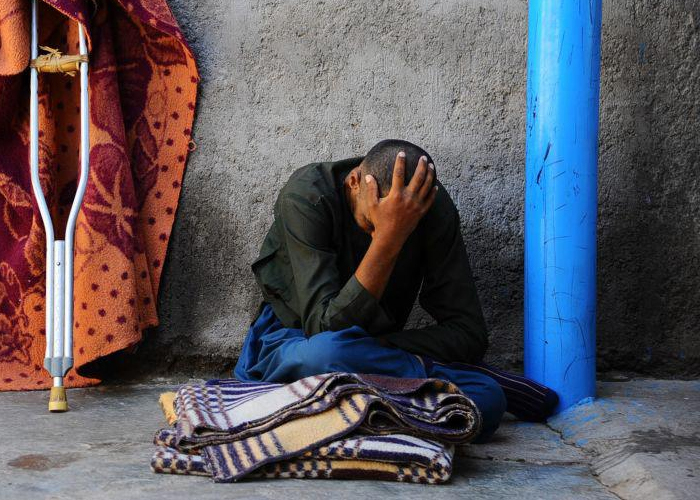One of the most pervasive consequences of war and violence has been psychological and psychophysical disease in Afghanistan. The forty-three-year war and violence have exposed people to different traumatic events that raise the chances of developing mental health problems such as post-traumatic stress disorder, anxiety, depression, and poorer life outcomes as adults. However, because of the Intangible nature of the mental health problems in the traditional context of Afghanistan, this problem has remained a silent crisis in the country. The concept of mental illness seems an alien and unfamiliar concept to most people. Most of the family violence is rooted in psychological problems but attributed to the ruling culture and patriarchal role of men. Even, the people feel shy to go to mental health experts while millions of people are affected by the problems.
The latest consequences of war and violence were observed on survivors of the Sayed al-Shuhada school in Kabul. After nearly two weeks from the deadly event which martyered at least 90 students and wounded nearly 250 others, many of the girls’ students are still struggling with the psychological effects of the incident and remain in a state of shock. Some figures show that at least 30 students were killed and wounded from just one class. “What haunts me are the voices of the wounded and the parents who were desperately shouting and searching for their children,” said Samira, a student at the school as local media report quoted. “When electricity is out, I fear a lot. I was so close; therefore, I was terrified by its sound. I get scared when I hear loud sounds,” said Nazanin Danesh, a student at the school as Tolonews reported yesterday. Sadly, this is more than forty years that Afghanistan has been witnessing such deadly events in the country.
According to a scientific study that was carried out by an EU project in recent years, nearly 85% of Afghan people are suffering from mental health problems. The EU-supported project report shows one out of five is not able to perform his normal role in Afghan society and so led to social problems. According to Afghan Independent Human Rights Commission, some 3,000 Afghans attempt suicide every year—and women make 80 percent of those attempts. In a country that is highly affected by war and poverty, weak people such as children, women, and minority groups face the most extreme conditions and they have limited resources for assistance and treatment. Forced child marriage, domestic abuse, social discriminations, and social and poverty pressures are only a few of the obstacles that Afghan people face. Since mental health care and suicide are extremely stigmatized in Afghanistan, many suicide attempts and severe mental health crises go unreported.
As pointed out, the people of Afghanistan have not only faced mental challenges because of war and violence but also because of widespread poverty, lack of electricity, lack of clean water, widespread social disorders, and also the outbreak of covid-19 as a new factor. A decade ago, UNICEF called Afghanistan the worst place in the world to be born while the situation has worsened due to the acceleration of war, violence, and poverty, and the outbreak of covid-19 in the country. A large number of people, especially the young Afghans are facing a crisis of hopelessness. Because of joblessness and hopelessness, the youths have lost motives to education and instead, they are rambling outsides and websites which normally led to social disorders.
The jobless youths are not only causing social disorders but also promote addiction in the country. Some immature youths use drugs to relieve the social and economic pain while the presence of drug users in different parts of the city has normalized the obscenity of addiction in the society and so the use of opium, cannabis, and other types of addictive substances have become rampant everywhere in the city or in the country. These addicts usually reside in Parks, sidewalks, under bridges, and anywhere in the city. For example, Pole-Sothta and its surroundings are famously considered as the area of addicts in Kabul, the capital city of the country. The spectacle of this stinking and ugly scene not only has a devastating effect on the psyche of society but also hunts down some unemployed and inexperienced young people.
Unfortunately, there is no comprehensive strategy to cope with the mental implications of war, violence, and addiction in Afghanistan. Even, the higher education system is not organized on basis of the social and economical needs of the country. If we look at private universities, there is no single private university that provides psychological educational services in the country. Accordingly, the public universities are not enough facilitated to provide clinical mental courses in the country in the area of psychophysical and few health centers are located in large cities such as Kabul and Mazar-e Sharif are not enough to satisfy the growing needs in the country.
Unfortunately, the national media have also not been able to present psychological awareness in the country. Unlike other countries, the T.V programs are not specialized and not responsibly present programs in accordance with the needs of the country. On one hand, they irresponsibly show the violent scene regardless of what social and psychological consequences it may impose on the people. On the other hand, most of the programs which are presented under name of psychological programs are not scientific and professional. In most of the programs, they bring some so-called experts who present some paternal advice, not scientific advices. The consequences of presenting such programs are the creation of distrusts amongst the people.

